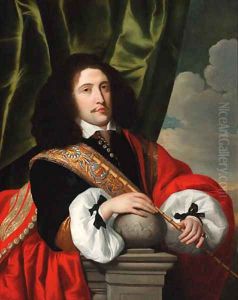Loedwijk Van Der Helst Paintings
Bartholomeus van der Helst was a prominent Dutch portrait painter who flourished during the Golden Age of Dutch painting. Born in Haarlem in 1613, his early life is somewhat shrouded in mystery, and there is little concrete information about his training and early career. However, it is widely believed that he moved to Amsterdam in the early 1630s, where he would establish himself as one of the leading portraitists of his time. Despite the common misnaming as 'Loedwijk,' his correct name is Bartholomeus van der Helst, and there appears to be no artist by the name of 'Loedwijk Van Der Helst' in historical records or art historical scholarship.
Van der Helst's work is characterized by its incredible attention to detail, rich color palette, and the ability to capture the personality and social status of his sitters. Unlike his contemporaries, such as Rembrandt, van der Helst's portraits often depicted his subjects in more flattering and idealized manners, which made his work highly sought after by the wealthy merchants and civic leaders of Amsterdam. His most famous work, 'The Banquet of the Amsterdam Civic Guard in Celebration of the Peace of Münster', completed in 1648, is a masterpiece of group portraiture and is considered one of the highlights of the Amsterdam Museum's collection.
Throughout his career, van der Helst received numerous commissions for individual and group portraits, and his success allowed him to lead a prosperous life. He was an integral part of Amsterdam's artistic community and was involved in the city's Guild of St. Luke, a common practice among artists of the time for networking and professional development. Despite the competition from other great artists of the era, van der Helst's ability to portray his subjects with dignity and grace ensured his place in the annals of art history.
Bartholomeus van der Helst died in Amsterdam in 1670, leaving behind a legacy that would influence Dutch portraiture for generations. His works are preserved in many prestigious museums around the world, showcasing his skill in capturing the essence of the Dutch Golden Age. Through his portraits, van der Helst provides a window into the society and culture of 17th-century Amsterdam, making him one of the most important painters of his time.
